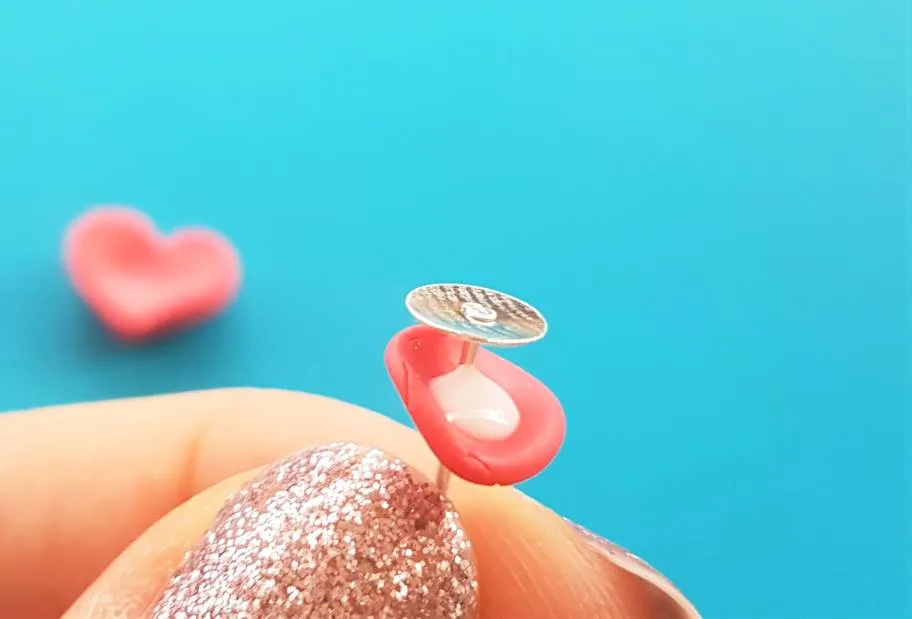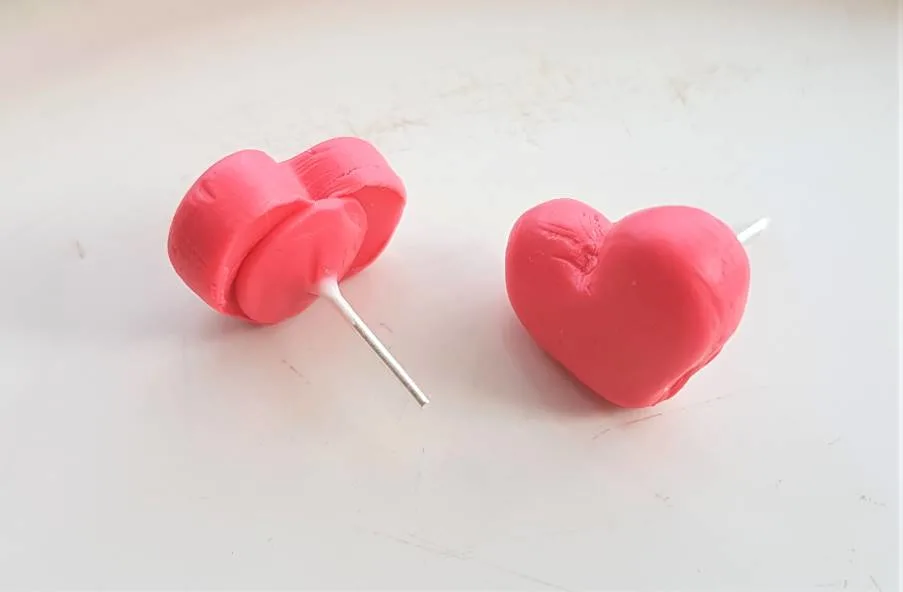Polymer clay earring making is a popular craft at the moment, with many looking to create studs for their jewellery collections and Etsy stores.
The question of how to attach stud backs to polymer clay earrings often arises when making studs, which I will be going into detail about in this article, however here is the short answer:
You can either attach stud backs to polymer clay earrings using super glue, baked on glue or by creating a mechanical hold with a second layer of polymer clay to secure the base of the stud back to the earring.
Here’s how to achieve the above, with a step-by-step breakdown of each method, to make sure you get the technique right…
This post may link to online stores. If you click a link and buy something, I may get a commission. Learn more.
How to attach a stud back to a polymer clay earring via a mechanical hold
1. Secure the stud back with an added layer of polymer clay
Securing the stud back with an added layer of polymer clay is the best method if you are making your earrings from slabs, using decorative cutters to shape your designs. This is called a mechanical hold, and is the strongest way to secure the stud post to your earring design.
Not all securing methods are completely proofed, as stress factors can still cause the stud back to snap off from the earring. However the mechanical hold method is the most reliable, although gluing is easier and quicker if you are batch making your earrings (scroll down for instructions of gluing if so).
Here’s how to do it:
Create a mechanical hold by adding a second layer of clay that will secure the post back to the back of the clay earring.
- Cut a little circle, smaller than the size your stud earring to cover the post back.
- Then skewer it onto the earring and push it down over the the stem of the earring, until it rests against the post back.
- Secure it with your fingertips, smoothing until the layer of clay has moulded with the stud earring, to completely enclose the stud back.
- If you like you can add a little polymer clay glue between the second layer and the earring, to ensure it’s fully secured.
- Bake the earring in your oven, according to the packaging instructions of your chosen brand of clay.


Another way to achieve a mechanical hold is to enclose the stud back in clay, add a little polymer clay glue to it and then press it against the back of the earring.
- Take a small amount of polymer clay that matches to the colour of the back of your stud earring (non-decorative side) and condition it until it is malleable.
- Mould it around the stud back, until it completely covers the metal pad.
- Take a small amount of polymer clay glue and add it to the covered stud back pad.
- Gently score the back of the polymer clay earring, where the stud back will attach. This need only be a small area, that will be covered by the stud back, and won’t compromise the overall design of the earring.
- Press the stud back to the back of the earring against the scored area. The scoring will help the glue adhere.
- Bake the earring in your oven, according to the packaging instructions of your chosen brand of clay.
Both of the above methods could also be done with a translucent clay, another coloured clay, or even a matching back to the earring; for example if you made your stud from a cane, add a second slice of the cane to form the back pad of the earring, to cover the stud back.
There are many ways to make this look beautiful, especially if you intend to sell your stud earrings as a product. Use contrasting colours, or a different design for the second layer of clay, to add more decorative elements to your earrings.
Or keep it simple, as I do, and just make the second layer from the same coloured clay as the base of your stud earring is made from.
I recommend using 6mm earring post backs like these so the flat pad is large enough to create a decent hold:
2. Mould the polymer clay earring around the stud back
Moulding the entire earring around the stud back works well if you are moulding a 3d stud earring as opposed to a flat one
Moulding the clay around the stud back in the beginning of the design process is an easy way of attaching the stud, if you are intending to make a 3D stud earring. You do this before you shape your design, as a first step.
If you are cutting your earrings from a slab, with a designed cutter, then this method will ruin the shape of the earring, as you’ll just end up squishing it around the stud back (so stick to the ‘second layer’ method I outlined above).
Here’s how to mould the earring around the stud back:
- Condition the base coloured clay of your stud earring between your palms until the clay is smooth and malleable.
- Roll the clay into a ball and begin to form it around the stud back, until the stud back is completely encased in clay. Make sure the stem of the earring is showing, and it is long enough to go through an earlobe and for a fastening to attach to it – don’t engulf the stem in clay, only the flat pad of the stud back.
- Then mould the clay into whatever design you like, with the stud back securely enclosed in the design.
- At this point you can add other colours of clay, and create your design.
- When done, bake your earring in the oven according to the packaging instructions of your chosen brand of clay.
This method of achieving a mechanical hold is super secure, as the stud back is fully imbedded in the design and won’t snap off easily. Bear in mind the stem of the earring could still break if applied to stress factors, but that’s the case for all earrings if they aren’t handled properly.
Let’s move onto attaching the stud back with glue, which is a less secure method, but it is much quicker and easier than the above and if done properly it can work really well…
How to glue a stud back to a polymer clay earring
There are multiple factors to consider when using glue to adhere metal jewellery to polymer clay. The strength of the final product all depends on the shape of the clay, how strong the brand of glue is, the shape of the stud back, how much stress can be put on the earring before it breaks, etc.
Whilst gluing isn’t a good as securing a post back with a mechanical hold, it can end up being quite secure, if done properly.
Gluing on post backs is favoured by many polymer clay earring artists, as it’s quick to do when making batches of earrings, and it’s easy. When done well, and with the right products, it works almost as well as a mechanical hold.
Here’s how to do it:
- Take your chosen brand of super glue and have it ready to use.
- Remove your stud earrings from the oven and wait for them to fully cool and harden (I suggest a few hours to 24 hours).
- Wipe the back of your earring with rubbing alcohol to remove any oils or dirt, so the glue has an even better chance of adhering.
- Apply your glue to a wipeable crafting mat or a plate and begin to dip the stud back into it.
- Press the stud back against the back of the earring and hold until secure.
- If your earring is flat, you can release the stud back if it has a flat pad, and allow it to adhere without the need to keep it steady with your fingers.
- Wait for the glue to dry fully, according to the packaging instructions of your chosen brand.
- Fasten the butterfly back or plastic back to the stem of your earrings and you are done.
Top tip: Before baking your earrings score the back of the earrings so the glue can adhere the stud back more easily to the area (glue works best on a scored surface as opposed to two smooth surfaces, and the stud back is less likely to snap off)
Please note, trying to add glue onto polymer clay that already has something on the surface, like varnish, acrylic paint or glitter is going to prove difficult, as the components will weak the bond very quickly. If you are adding varnish, acrylic paint or mica powder to your earring designs, make sure you leave a space on the back for the glue to adhere to, that is free of oils, dirt and any other materials.
Which glue to use when attaching stud backs to polymer clay earrings?
E6000 is highly recommended and often talked about in the polymer clay crafting community. It’s a great glue for crafting projects and bonds very well.
Whilst it does create a strong initial bond and is versatile, be warned that over time the components in the glue may cause the polymer clay earring to become brittle and break. This will take a long while (a few years), so it is a fairly reliable glue, with many crafting fans.
Buy E6000 here:
Gorilla Glue is another effective super glue to use with polymer clay. A lot of super glues don’t hold up well on plastics (which is what polymer clay is made from; a mix of dyes, fibres, polymer plastics and other materials), as they are bendy and the dried glue becomes flaky and brittle when bent. But as Gorilla Glue offers a range of glues with a flexible gel element, it holds up well when naturally bent by a bendy surface, like polymer clay.
Get Gorilla Glue here:
Your baked clay may appear hard, but it will have a slightly flexible finish, so choosing a glue that works well with that in mind is essential. Gel formulated super glues work best, in this case.
Please note super glues will deteriorate with heat, so do not add them to your stud earring designs before baking. Ensure your earrings are fully cooled and hardened, perhaps even waiting up to 24hrs, before applying the glue.
Although there are bake on glues such as fimo deco gel, which adhere metal to polymer clay during the baking process, which come highly recommended. If you would like to bake the glue onto the design, this is a great option.
Don’t use crafting glues such as PVA glue as this simply won’t work. It will not create a strong enough bond and the earring back will easily pop off. Stick to the above for a better result.
Another thing to note is different brands of glue will perform differently with each brand of polymer clay. It’s best to experiment with glues until you find one that works best with your chosen brand of polymer clay, especially if you plan on crafting batches of products to sell.
Learning your tools is essential, and will make for smoother crafting and selling in the long run. You want to avoid earring backs snapping off at all costs, or you will end up with some unsatisfied customers.
Ultimately I would recommend creating a mechanical hold for your earring stud backs, as outlined above.
Related Questions
Can I use resin to attach stud backs to polymer clay earrings?
Yes resin can be used for this, if you are familiar with resin crafting. Resin creates a permanent bond, which results in a very strong hold for the stud back. Resin can also be used to encase polymer clay, to create a strong and shiny effect.
Epoxy resin is a favoured resin amongst polymer clay crafters, if you would prefer this method of attaching your stud backs.
Conclusion
I hope you found this article helpful on ‘How to Attach Stud Backs to Polymer Clay Earrings’ and you now feel confident to head to your crafting table and try out the different methods for yourself!
Whether you choose to glue on your stud backs, or to create a mechanical hold, keep in mind the above tips and tricks to help you get it right, for long lasting earrings.
It’s my goal to make the world of polymer clay earring crafting as easy as possible for beginners.
For more information on crafting polymer clay earrings, check out the below:
I also provide articles on: a How-to Guide to make polymer clay earrings for beginners, a Sales Guide for selling polymer clay earrings on Etsy, a comprehensive Cost Guide, and a bumper list of earring Design Ideas, so you’re never stumped by clay-makers block!

Lorna is a footwear geek and the founder of Wearably Weird. She created a YouTube channel in 2021 for fellow footwear fanatics, dedicated to detail-rich footwear reviews and info. She has a fashion media qualification (awarded in 2011).
